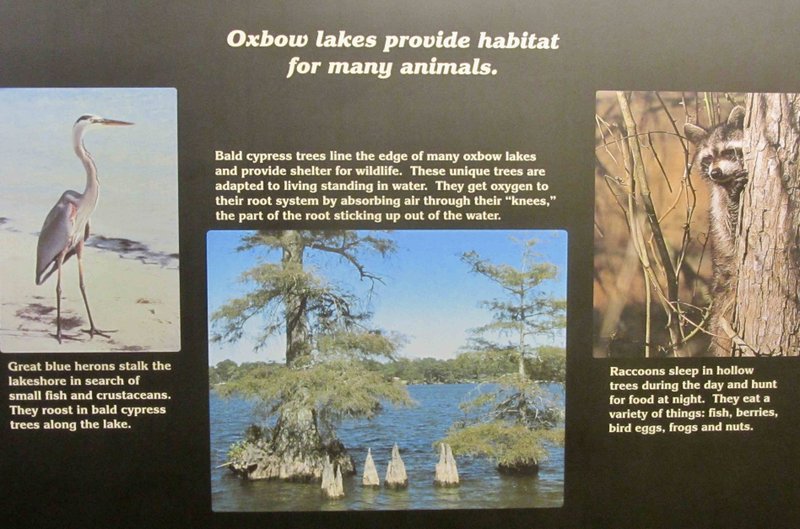LAKE CHICOT STATE PARK — Ten Arkansas state parks have "lake" in their name. But only one of them is entirely a natural lake rather than a man-made body of water.
That's Lake Chicot, in the far southeastern corner of the Natural State. This lake, formed around six centuries ago by the meandering of the Mississippi River, can boast other distinctions. It is Arkansas' largest natural lake as well as the largest oxbow lake in North America.
There are said to be at least 2,340 named lakes in Arkansas — boatloads of fresh water, although no match for Minnesota, "Land of 10,000 Lakes." Lake Chicot is one of our state's most intriguing, not only for its size, but also for other distinctions as noted at Lake Chicot State Park's visitor center.
An oxbow is a U-shaped lake formed when a meander from the main flow of a river like the Mississippi is cut off to form a free-standing body of water. The name stems from its curved shape, resembling the bow pin of a yoke that links two plowing oxen. (Devotees of the classic Down Under song "Waltzing Matilda" may want to know that in Australia, "billibong" is the name for an oxbow lake.)
Lake Chicot, whose shape also resembles a sliver of a crescent moon, is a magnet for fishing enthusiasts as well as birdwatchers. Exhibits at the visitor center, including an orange kayak, focus on various recreational possibilities. For overnight stays, the park rents 14 cabins and 127 campsites.

A brochure touts the park's natural allures, "situated in a grove of majestic wild pecans and ringed with cypress trees standing literally 'up to their knees' in water. ... The park also has the state champion Nutall's oak tree. True Delta country can be found in this corner of Arkansas."
Two pamphlets map out theme driving tours starting at the visitor center. The self-guided Levee Tour pinpoints sites of interest along 30 miles of paved and gravel roads in the park's vicinity. Motorists are alerted that "most of the levee is grazed by cattle, so be prepared to drive through cow pies."
Highlights of this drive include Luna, "once an important river landing" where "Confederate guerrillas attacked and disabled two Union transports"; Leland Chute, where "the rare and unusual paddle fish is sometimes caught"; Hyner Cemetery, with graves of Italian immigrants who came to the then malarial region in the late 1890s as plantation workers; and "a weedy mound built by prehistoric American Indians a millennium ago."
Luna also is one of the marked stops in the pamphlet for the Civil War Driving Tour along the lake's outer rim. Other spots include Lakeport Plantation, Arkansas' only antebellum home on the National Register of Historic Places; Worthington's Red Leaf Plantation, where Union troops forced a Confederate retreat on the evening of June 5, 1864; and the Saunders House, used as a hospital for Confederate wounded.
What the Encyclopedia of Arkansas History and Culture calls "the small but significant role" Arkansas played in a world-famous later event is celebrated by a marker along Arkansas 159 a bit south of Lake Village.
"ln April 1923 [Charles] Lindbergh, then an unknown 21-year-old mail pilot, experienced engine trouble and landed his airplane on the now-abandoned golf course behind the site of the old Lake Village County Club," reads the sign. "He remained in Lake Village overnight. During the evening, he took his host, Mr. Henry, for a moonlit flight down the Mississippi River and over Lake Village. It was the first time that Lindbergh had flown after dark."
The Arkansas encyclopedia observes that "four years later, Lindbergh was able to use the night-flying skills that he first tried in Arkansas by flying day and night in the first nonstop solo flight across the Atlantic."
Lake Chicot State Park's visitor center, on Arkansas 257, is open 8 a.m.-5 p.m. daily; through July 8, extended Thursday and Friday hours are 8 a.m.-8 p.m. Admission is free. The location is 9 miles northeast of Lake Village via U.S. 65 and Arkansas 144. Visit arkansasstateparks.com or call (870) 265-5480.
Style on 04/02/2019
CORRECTION: Lake Chicot State Park covers 212 acres; Lake Chicot covers about 5,000 acres. An earlier version of this story underestimated the lake.
